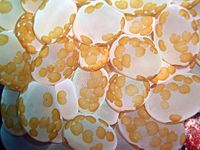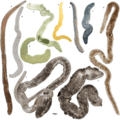Acoelomorpha facts for kids
Quick facts for kids Acoelomorphs |
|
|---|---|
 |
|
| Waminoa (orange-yellow) sp. on Plerogyra sp.. | |
| Scientific classification | |
| Kingdom: | |
| Subkingdom: | |
| Superphylum: | |
| Phylum: | |
| Subphylum: |
Acoelomorpha
|
The Acoelomorpha are a special group of tiny animals. For a long time, scientists thought they were a type of flatworm.
In 2004, new molecular studies changed this idea. These studies looked closely at the animals' DNA. They showed that acoelomorphs are not flatworms after all.
Now, scientists know that the closest relatives of acoelomorphs are animals called Xenoturbellida. These two groups together form a new, larger group called the Xenacoelomorpha.
What are Acoelomorphs?
Most scientists believe acoelomorphs are very old branches on the animal family tree. They are considered to be among the first bilateria. Bilateria are animals with a body that has two similar sides. Acoelomorphs are slightly more complex than animals like Cnidaria (jellyfish and corals).
Recent studies suggest that acoelomorphs (along with Xenoturbella) might be very early members of the deuterostomes. Deuterostomes are a large group of animals that includes humans, starfish, and acorn worms. Scientists are still working to fully understand where acoelomorphs fit in the history of life.
One research project stated:
- "The results show that the two groups constitute a newly classified phylum... which the authors name the ’Xenacoelomorpha’. The xenacoelomorph phylum joins the three known phyla of deuterostomes: vertebrates (including humans), echinoderms (e.g. starfish) and hemichordates (acorn worms)".
Where Acoelomorphs Live
Acoelomorphs almost always live in the ocean. You can find them in different places:
- They live between tiny grains of sediment on the seafloor.
- Some swim as plankton, floating in the water.
- Others crawl slowly on algae or other surfaces.
Acoelomorphs have a special organ called a statocyst. This organ helps them sense gravity. It helps them know which way is up and down. Their bodies are very soft, which makes them hard to study and classify.
Images for kids
-
Xenoturbella, the sister group to acoelomorphs
See also
 In Spanish: Acoelomorpha para niños
In Spanish: Acoelomorpha para niños




